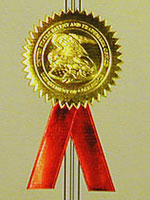Recent News
NQVL Design Phase Award
October 1, 2025
CHTM Joins NSF's NQVL Pilot Projects
August 9, 2024
OSE PHD, Dr. Xuefeng Li - Wins The Outstanding Interdisciplinary Graduate Programs Award
May 10, 2024
Dr. Ali Rastegari - 2024 OSE Best Dissertation Award Winner
May 10, 2024
News Archives
CHTM Faculty Members are well represented in UNM patent list
May 23, 2016 - CHTM, STC

A number of CHTM faculty members are included as inventors in the patent count for UNM for the third quarter.
The U.S. Patent & Trademark Office (USPTO) recently issued nineteen patents to STC during January, February, and March of 2016 for technologies invented at the University of New Mexico. Eight patents name CHTM faculty as inventors.
Visit the original story at STC.UNM for the complete list of patents and the UNM academic departments whose faculty contributed research.
CHTM faculty members are listed on these patents:
2016 - January, February, March
Issued patent for “Structural Illumination and Evanescent Coupling for the Extension of Imaging Interferometric Microscopy”
Patent No. 9,239,455, issued January 19, 2016
Inventors: Steven R. J. Brueck, Yuliya V. Kuznetsova, Alexander Neumann
This technology uses a low numerical-aperture (NA) microscope objective to obtain high-frequency partial images using simultaneous coherent off-axis illumination beams and different methods of creating the image. The benefits of this flexibility require only minimal access to the objective pupil, making the invention much more adaptable to current technology. Applications include semiconductor manufacturing and microscopy of biological subjects.
Issued Patent for “Suppressing Optical Loss in Nanostructured Metals by Increasing Self-Inductance and Electron-Path Length”
Patent No. 9,246,031, issued January 26, 2016
Inventors: Sang Eon Han, Samuel Clark
This technology is a method for using helical coils that can render metals transparent. The helical-coiled ribbon nanostructures are comprised of two metal electrode layers that sandwich a semiconductor active layer and are periodically arranged to form an array. Tests have shown that light is able to pass through the metal electrode layers and be absorbed by the semiconductor, giving credence to the metals being transparent. The absorption rate in the semiconductor of the helical structure is an order of magnitude higher than for tubular or planar structures.
Issued patent for “Gate-All-Around Metal-Oxide-Semiconductor Transistors With Gate Oxides”
Patent No. 9,257,535, issued February 9, 2016
Inventors: Seung-Chang Lee, Steven R. J. Brueck, Daniel F. Feezell
This gate-all-around FET technology uses well-defined nano-scale floating current channel from source to drain. The current channel is surrounded with Group III oxide formed by liquid phase chemical-enhanced oxidation for thermal stability, providing less leakage, greater performance, and longevity for use in semiconductors, integrated circuit, and transistors.
Issued patent for “High-Efficiency, Light-Absorbing and Light-Emitting Nanostructures”
Patent No. 9,267,889 issued, February 23, 2016
Inventors: Mike Klopfer, Ravinder K. Jain
This technology is a method for producing high-brightness plasmonic quantum-dot nanostructures that eliminates cadmium toxicity by shielding the quantum dot in a nanoshell. The technology allows for new medical research and clinical applications such as biomedical imaging, deep-tissue imaging and phototherapy.
Issued patent for “Low Defect-Density, Lattice-Mismatched Semiconductor Devices and Methods of Fabricating Same”
Patent No. 9,269,569, issued February 23, 2016
Inventors: Sang M. Han, Darin Leonhardt
This technology is a novel method for terminating dislocations in crystalline films heteroepitaxially grown on lattice-mismatched substrates and preventing these dislocations from propagating into subsequently grown films. Applications include low-cost photovoltaics, optoelectronics, semiconductor fabrication, and photonic devices.
Issued patent for “Semiconductor Device and Method of Making the Device”
Patent No. 9,269,724, issued February 23, 2016
Inventors: Sang M. Han, Darin Leonhardt, Ghosh Swapnadip
This technology is a novel method for mitigating the stress induced by thermal expansion coefficient mismatch for semiconductor devices. A SiO 2 nanotemplate structure is used to block the threading dislocations and reduce the thermal stress due to thermal expansion coefficient mismatch between Ge and Si. The SiO 2 template leaves voids around the template sidewall and top surface, which relieve stress caused by the thermal expansion coefficient mismatch between the film and the substrate.
Issued patent for “High-Efficiency, Light-Absorbing and Light-Emitting Nanostructures”
Patent No. 9,267,889 issued, February 23, 2016
Inventors: Mike Klopfer, Ravinder K. Jain
This technology is a method for producing high-brightness plasmonic quantum-dot nanostructures that eliminates cadmium toxicity by shielding the quantum dot in a nanoshell. The technology allows for new medical research and clinical applications such as biomedical imaging, deep-tissue imaging and phototherapy.
Issued patent for “High-Q Optical Resonators and Method of Making the Same”
Patent No. 9,285,535, issued March 15, 2016
Inventors: Ravinder K. Jain, Mani Hossein-Zadeh
This technology is a simple and reliable new method for fabricating high-Q WGM optical microresonators in several mid-IR relevant glasses. The method is very practical for creating spheres with minimal bulk and surface defects. Applications include mid-IR spectroscopic sensors, mid-IR microsphere lasers and novel mid-IR luminescent light sources.


